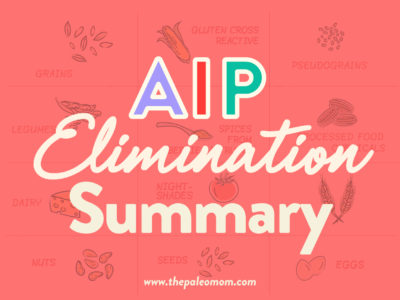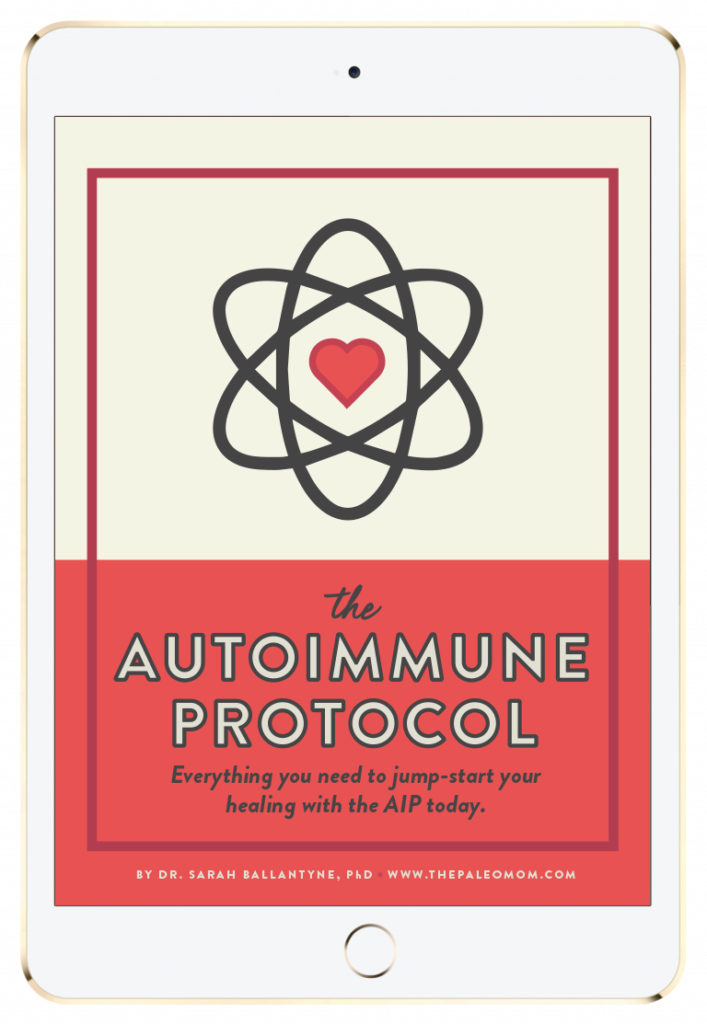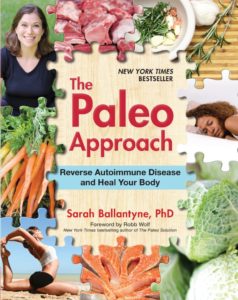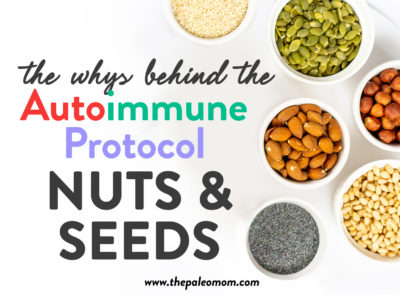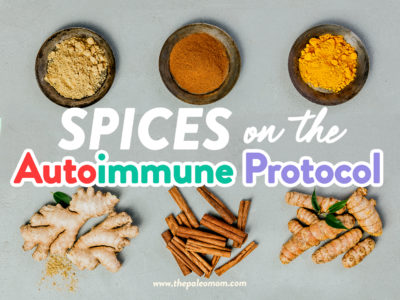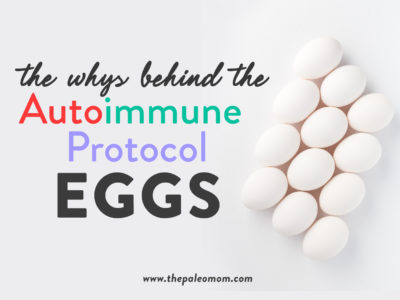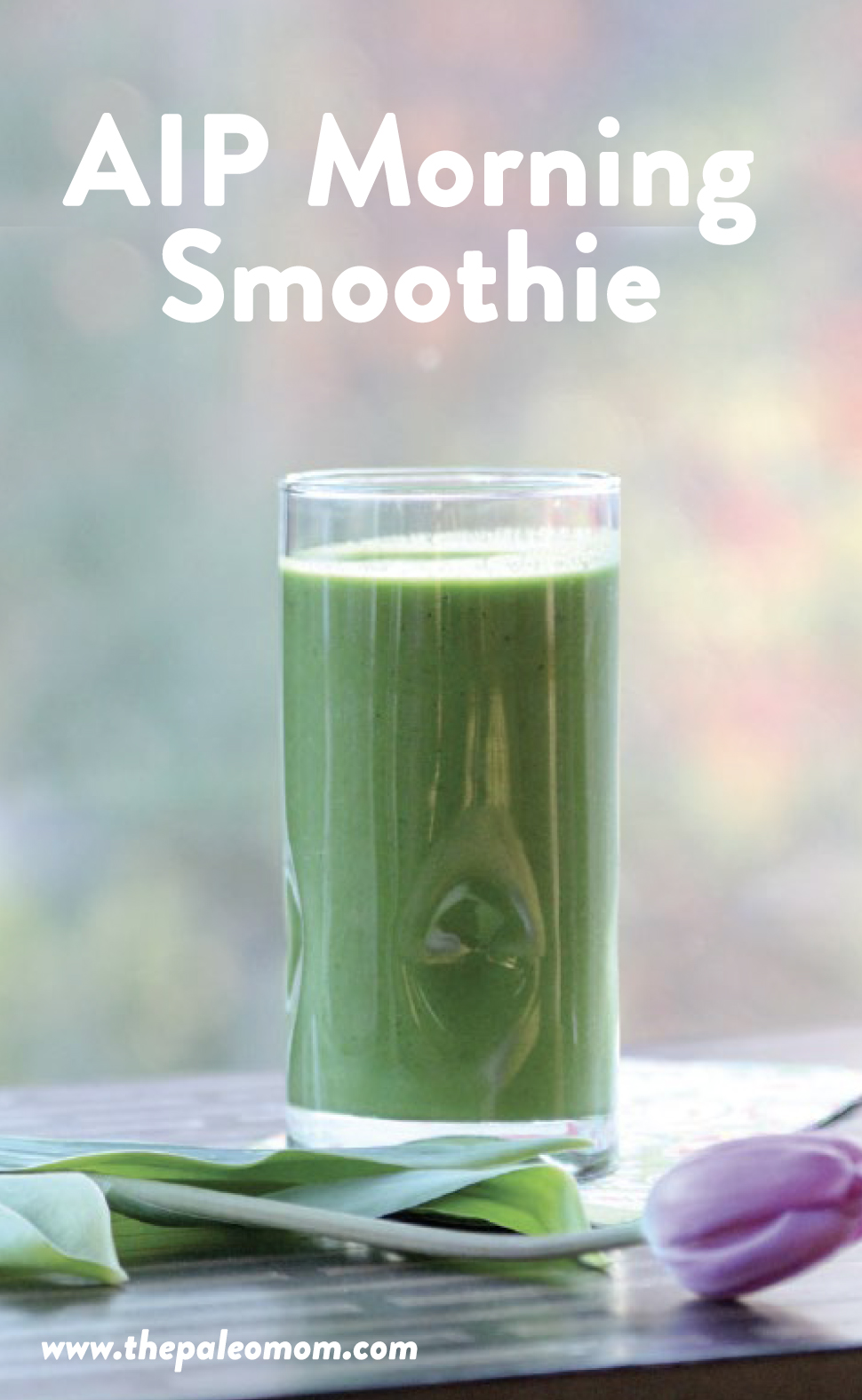 As you adopt the Autoimmune Protocol, your food choices become focused on consuming the nutrients to support healing—foods that provide everything your body needs to stop attacking itself, repair damaged tissues, and get healthy again: proteins, carbohydrates, and fats to sustain a normal metabolism, build new tissue, and produce hormones, important proteins, and signaling molecules; fiber to support a healthy and diverse gut microbiome; and the full range of fat-soluble vitamins, water-soluble vitamins, minerals, antioxidants and other micronutrients to get rid of inflammation, regulate the immune system, and support the normal functioning of all the body’s systems.
As you adopt the Autoimmune Protocol, your food choices become focused on consuming the nutrients to support healing—foods that provide everything your body needs to stop attacking itself, repair damaged tissues, and get healthy again: proteins, carbohydrates, and fats to sustain a normal metabolism, build new tissue, and produce hormones, important proteins, and signaling molecules; fiber to support a healthy and diverse gut microbiome; and the full range of fat-soluble vitamins, water-soluble vitamins, minerals, antioxidants and other micronutrients to get rid of inflammation, regulate the immune system, and support the normal functioning of all the body’s systems.
Table of Contents[Hide][Show]
I am a firm believer that focusing on what we DO eat (rather than what we eliminate) is a major factor in our success in following a dietary plan, which is why my preference is always to begin a discussion about the AIP by elaborating on the wide array of delicious and nourishing foods to eat. Maybe we can simply chalk it up to positive thinking, but I feel that defining a diet based on what’s omitted sets us up to feel deprived, magnifying cravings, resentment and eventually rebellion (which leads to falling off the wagon). That being said, it’s still essential to be aware of which foods to avoid and why, because a therapeutic diet isn’t just about eating more of the good; it’s also about avoiding the bad.
The AIP diet goes beyond nutrient sufficiency to also omit problematic foods—meaning any food that has the capacity to undermine our health, whether by increasing inflammation, damaging the gut, negatively affecting hormones, or causing other problems. The AIP also respects bioindividuality, acknowledging that not all of the eliminated foods will be harmful for all individuals, and encourages self-experimentation with a phased approach. The foods that are avoided during the Elimination Phase of the AIP can be methodically challenged and reintroduced in the Reintroduction Phase, in order to hone in on a personalized optimal diet to support health in the Maintenance Phase. See also The 3 Phases of the Autoimmune Protocol and Reintroducing Foods after Following the Autoimmune Protocol.
Rationale for AIP Eliminations
Some foods are inherently inflammatory. It’s actually quite surprising just how many different ways foods can cause inflammation. Processed foods, fast food, foods made with processed “vegetable” oils, grains, legumes, nuts and seeds are all high in omega-6 fatty acids, which control cell signaling that turns on inflammation. See also What About Fat?, Why Grains Are Bad-Part 2, Omega 3 vs. 6 Fats, Why Vegetable Oils are Bad, Trans Fats: What Are They, and Why Are They Bad? and Which Fats Should You Eat?
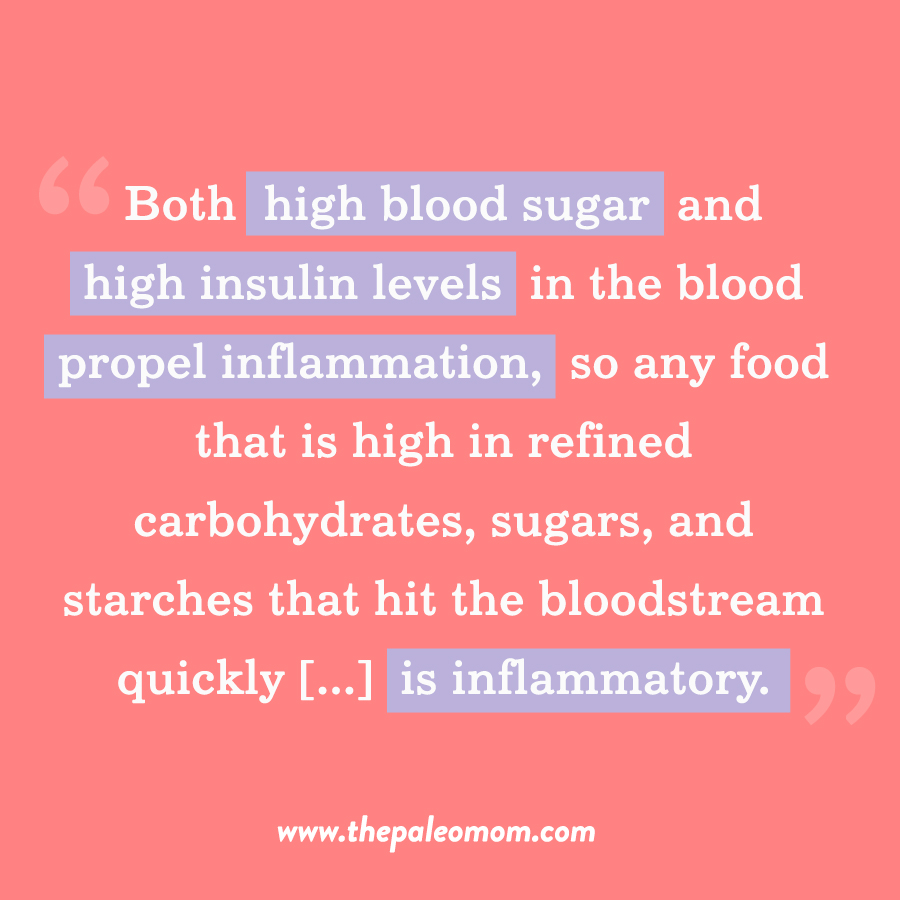 Both high blood sugar and high insulin levels in the blood propel inflammation, so any food that is high in refined carbohydrates, sugars, and starches that hit the bloodstream quickly (owing to the absence of compounds in the food that slow the digestion of carbohydrates, such as fiber) is inflammatory. These foods also negatively impact many other hormones, thanks to all the effects that insulin has in the body. Insulin is a hormone that affects many other systems in the human body, and having insulin in the happy-medium range is critical for health. Excess refined carbohydrates also negatively impact two other important hormones: leptin and ghrelin. These hormones help control our appetite, metabolism, and immune systems. Okay, so there go processed foods, fast food, and junk food. But then, those foods were already on the blacklist because they don’t possess any nutritionally redeeming properties. What’s less commonly known is that many foods considered to be healthy, like multigrain bread and low-fat dairy products, also spike blood sugar and insulin levels. See also The Hormones of Fat: Leptin and Insulin, The Hormones of Hunger, How Many Carbs Should We Eat?, 3 Ways to Regulate Insulin that Have Nothing to Do With Food, and The Case for More Carbs: Insulin’s NonMetabolic Roles in the Human Body.
Both high blood sugar and high insulin levels in the blood propel inflammation, so any food that is high in refined carbohydrates, sugars, and starches that hit the bloodstream quickly (owing to the absence of compounds in the food that slow the digestion of carbohydrates, such as fiber) is inflammatory. These foods also negatively impact many other hormones, thanks to all the effects that insulin has in the body. Insulin is a hormone that affects many other systems in the human body, and having insulin in the happy-medium range is critical for health. Excess refined carbohydrates also negatively impact two other important hormones: leptin and ghrelin. These hormones help control our appetite, metabolism, and immune systems. Okay, so there go processed foods, fast food, and junk food. But then, those foods were already on the blacklist because they don’t possess any nutritionally redeeming properties. What’s less commonly known is that many foods considered to be healthy, like multigrain bread and low-fat dairy products, also spike blood sugar and insulin levels. See also The Hormones of Fat: Leptin and Insulin, The Hormones of Hunger, How Many Carbs Should We Eat?, 3 Ways to Regulate Insulin that Have Nothing to Do With Food, and The Case for More Carbs: Insulin’s NonMetabolic Roles in the Human Body.
Several compounds found in grains (even whole grains), legumes, and nightshades are inflammatory. Compounds called agglutinins (particularly wheat germ agglutinin, kidney bean lectin, soybean lectin, tomato lectin, and peanut lectin) and glycoalkaloids (found in nightshades such as tomatoes, potatoes, eggplants, and peppers) are such potent inducers of inflammation and stimulators of the immune system that several of these compounds have been investigated for use in chemotherapy or for use in vaccines as adjuvants, chemicals added to vaccines to ramp up the immune system. They’re a necessary aspect of how vaccines work, but not a desirable property of food! See also Are all lectins bad? (and what are lectins, anyway?), Why Grains Are Bad-Part 1, Lectins and the Gut, Worse than Gluten: The Agglutinin Class of Lectins, What Are Nightshades?, and The WHYs behind the Autoimmune Protocol: Nightshades.
Some foods are inherently damaging to the gut, usually because they either harm the beneficial microorganisms that live in the digestive tract or damage or alter the cells that form the gut barrier, whose job is to transport nutrients to the bloodstream while stopping everything else from getting in.
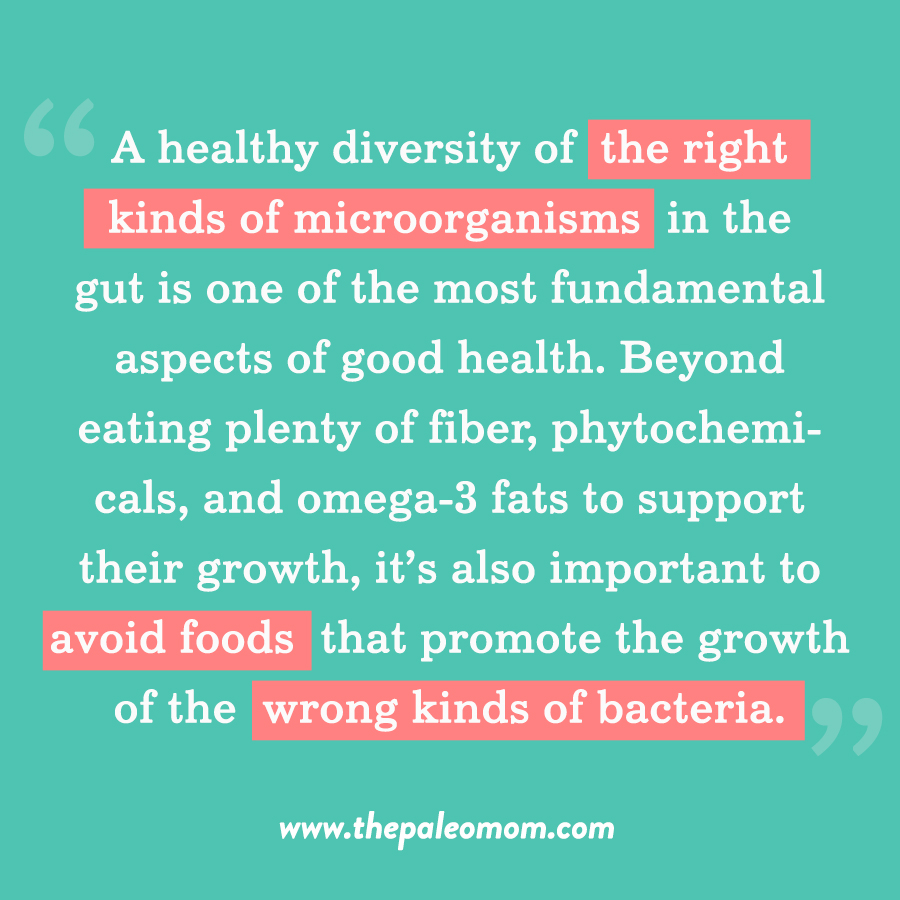 The microorganisms that live in our gut are essential to our health. They help us digest food, regulate the gut barrier, and regulate our immune system. A healthy diversity of the right kinds of microorganisms in the gut is one of the most fundamental aspects of good health. Beyond eating plenty of fiber, phytochemicals, and omega-3 fats to support their growth, it’s also important to avoid foods that promote the growth of the wrong kinds of bacteria. Grains, dairy, legumes, nightshades, and alcohol are all known to contain compounds that can hinder the growth of beneficial strains of bacteria while supporting the growth of undesirable strains of bacteria, like E. coli. Additionally, pesticides including glyphosate (the active ingredient in Roundup) skew the microbial balance in the gut towards undesirable strains, an argument for choosing organic whenever possible. See also What Is the Gut Microbiome? And Why Should We Care About It? and Water Quality and the Gut Microbiome.
The microorganisms that live in our gut are essential to our health. They help us digest food, regulate the gut barrier, and regulate our immune system. A healthy diversity of the right kinds of microorganisms in the gut is one of the most fundamental aspects of good health. Beyond eating plenty of fiber, phytochemicals, and omega-3 fats to support their growth, it’s also important to avoid foods that promote the growth of the wrong kinds of bacteria. Grains, dairy, legumes, nightshades, and alcohol are all known to contain compounds that can hinder the growth of beneficial strains of bacteria while supporting the growth of undesirable strains of bacteria, like E. coli. Additionally, pesticides including glyphosate (the active ingredient in Roundup) skew the microbial balance in the gut towards undesirable strains, an argument for choosing organic whenever possible. See also What Is the Gut Microbiome? And Why Should We Care About It? and Water Quality and the Gut Microbiome.
There are two main ways foods directly damage the gut barrier: by adversely affecting the health of the cells that form the gut barrier or by interfering with how those cells bond together. Both of these cause the barrier to become permeable, or “leaky” (hence “leaky gut syndrome,” the umbrella term for chronic diseases associated with this problem). Many compounds that are supposed to stay inside the gut (like toxins, waste products, and even otherwise beneficial microorganisms) are able to pass into the body, where they can stimulate the immune system. Grains, legumes, dairy, nuts, seeds, nightshades, alcohol, non-nutritive sweeteners, and emulsifiers all contain substances that increase the permeability of the gut either directly, by damaging the cells that form the gut barrier or opening up the bonds between them, or indirectly, by feeding the wrong kinds of microorganisms in the gut or by stimulating intestinal inflammation. These harmful substances include prolamins (like gluten) and agglutinins, digestive enzyme inhibitors, glycoalkaloids, and phytic acid. NSAID medications also negatively impact gut barrier function. See also What Is A Leaky Gut? (And How Can It Cause So Many Health Issues?), What Should You Eat To Heal a Leaky Gut?, Which comes first: the leaky gut or the dysfunctional immune system?, 8 Nutrients for Leaky Gut, How Gluten (and other Prolamins) Damage the Gut, Worse than Gluten: The Agglutinin Class of Lectins, The WHYs behind the Autoimmune Protocol: Nightshades, Is It Paleo? Guar Gum, Xanthan Gum and Lecithin, Oh My!, How Do Grains, Legumes and Dairy Cause a Leaky Gut? Part 2: Saponins and Protease Inhibitors, Why is High Fructose Corn Syrup Bad For Us?, Is It Paleo? Fructose and Fructose-Based Sweeteners (I’m looking at you, Agave!), Is It Paleo? Splenda, Erythritol, Stevia and other low-calorie sweeteners, The WHYs behind the Autoimmune Protocol: Alcohol, Saturated Fat: Healthful, Harmful, or Somewhere In Between?
 Gluten-containing grains are particularly problematic foods thanks to gluten’s direct effect on gut barrier integrity, but also because antibody formation against gluten peptides is extremely common in autoimmune disease. And, there are similar enough proteins in other grains, dairy products, some legumes and pseudograins that antibodies against gluten also recognize proteins in these foods, a process called gluten cross-reactivity. The most common gluten cross-reactors are also eliminated on the AIP. See also How Gluten (and other Prolamins) Damage the Gut and Gluten Cross-Reactivity: How your body can still think you’re eating gluten even after giving it up.
Gluten-containing grains are particularly problematic foods thanks to gluten’s direct effect on gut barrier integrity, but also because antibody formation against gluten peptides is extremely common in autoimmune disease. And, there are similar enough proteins in other grains, dairy products, some legumes and pseudograins that antibodies against gluten also recognize proteins in these foods, a process called gluten cross-reactivity. The most common gluten cross-reactors are also eliminated on the AIP. See also How Gluten (and other Prolamins) Damage the Gut and Gluten Cross-Reactivity: How your body can still think you’re eating gluten even after giving it up.
A handful of foods are additionally problematic because of their impact on hormones. This includes coffee (impacting cortisol) and stevia (an endocrine disruptor, impacting testosterone and progesterone). Other foods simply facilitate inflammation, such as egg whites, which contain a compound called lysozyme that acts as a carrier molecule for other proteins (food proteins, bacterial proteins) to get inside the body and interact with the immune system. See also Coffee and Autoimmune Disease, The Trouble with Stevia, What’s the Next Superfood Sweetener? and The WHYs behind the Autoimmune Protocol: Eggs.
Finally, some foods are only problematic in large quantities. Salt (it’s best to always consume unrefined sea salt because it contains dozens of trace minerals) should be limited to 1 to 2 heaping teaspoons per day (equating to 5-6 grams of sodium per day). Fructose consumption (even from fresh fruit) should be limited to 40 grams daily, and it’s best to aim for 10 to 25 grams daily. Tea is beneficial to the microbiome, but it does still contain caffeine, so its consumption should be limited to the morning hours and attention should be paid to its effect on sleep quality. Honey and blackstrap molasses are superfood sweeteners (honey because it benefits the microbiome, and blackstrap molasses because it’s so crazy nutrient-dense), yet all natural sugars should only be consumed in moderation, keeping intake to less than 10% total calories. See also Is Salt Paleo?, Fructose and Vitamin D Deficiency: The Perfect Storm?, Is Fructose a Key Player in the Rise of Chronic Health Problems?, How Does Sugar Fit into a Healthy Diet?, The Health Benefits of Tea, Blackstrap Molasses: The Sugar You Can Love!, and Honey: The Sweet Truth About a Functional Food!.
Save 70% Off the AIP Lecture Series!
Learn everything you need to know about the Autoimmune Protocol to regain your health!
I am loving this AIP course and all the information I am receiving. The amount of work you have put into this is amazing and greatly, GREATLY, appreciated. Thank you so much. Taking this course gives me the knowledge I need to understand why my body is doing what it is doing and reinforces my determination to continue along this dietary path to heal it. Invaluable!
Carmen Maier
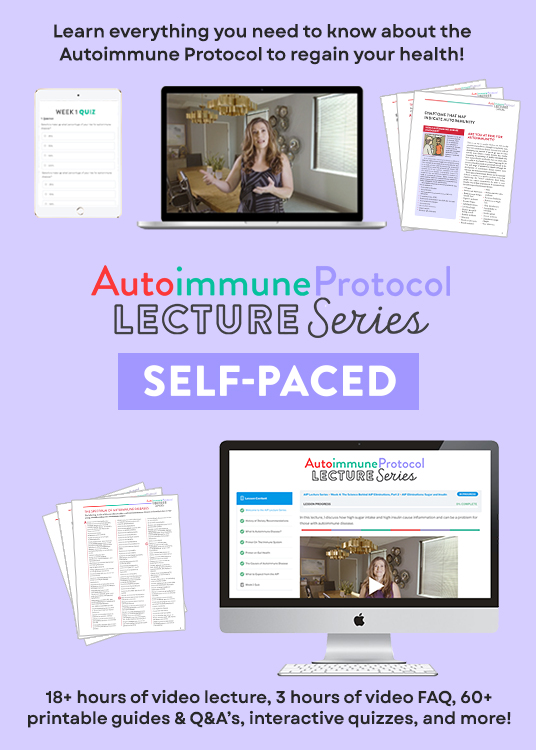
This may be an oversimplification, but we can lump together all the health-promoting nutrients in foods as “Good Stuff” and all the health-undermining compounds in foods as “Bad Stuff.” When evaluating the merits of an individual food, we can weigh how much Good Stuff is in that food versus how much Bad Stuff. Some foods have tons of Good Stuff and no Bad Stuff—these are the definite “yes” foods! We can eat plenty of them with no guilt. Other foods have tons of Bad Stuff and very little Good Stuff—these are the definite “no” foods and should be avoided the vast majority of the time. Those foods that fall somewhere in-between are the best candidates for early challenge and reintroduction, see The 3 Phases of the Autoimmune Protocol and Reintroducing Foods after Following the Autoimmune Protocol.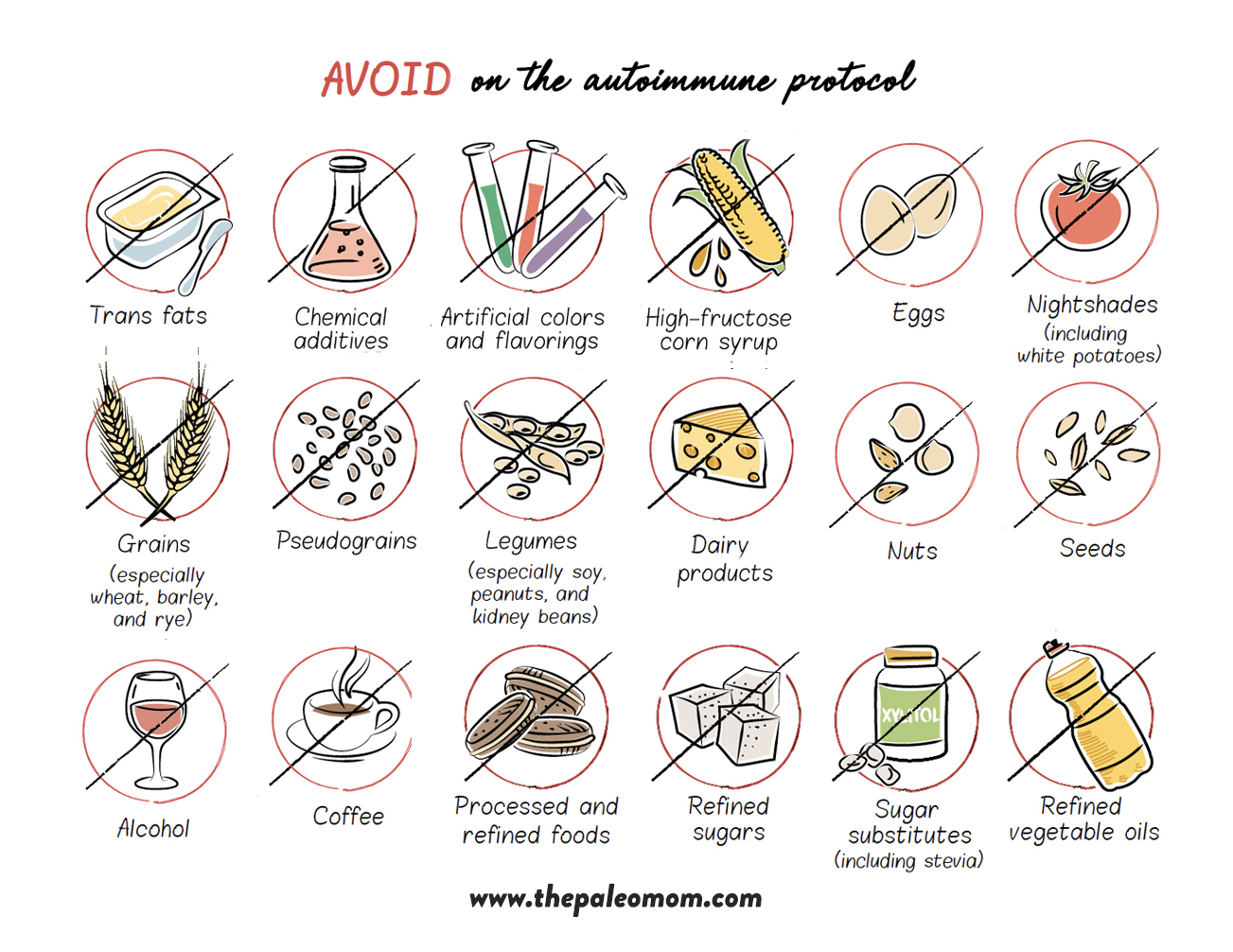
AIP Foods to Avoid List
While the following may seem like an extensive list of foods to eliminate, it’s important to emphasize that the wealth of delicious health-promoting foods to eat on the Autoimmune Protocol is a vastly longer list. It’s also extremely helpful to dig into the why’s behind the eliminations, which can help direct priorities for transition, currency buy-ins, and identify missteps. See also Transitions: All In or Baby Steps?, Making Healthy Choices: What’s Your Currency?, AIP Do’s and Don’ts and Is the Autoimmune Protocol Too Hard?.
The following are eliminated during the first phase of the AIP.
Grains: barley, corn, durum, fonio, Job’s tears, kamut, millet, oats, rice, rye, sorghum, spelt, teff, triticale, wheat (all varieties, including einkorn and semolina), and wild rice. Also avoid wheat grass, barley grass, oat grass, spelt grass, bran and any other product made from any part of the grain plant. See also Why Grains Are Bad-Part 1, Lectins and the Gut, Are all lectins bad? (and what are lectins, anyway?), Why Grains Are Bad-Part 2, Omega 3 vs. 6 Fats, Why Grains Are Bad-Part 3, Nutrient Density and Acidity, How Do Grains, Legumes and Dairy Cause a Leaky Gut? Part 2: Saponins and Protease Inhibitors, and Grains: What Are They?.
Gluten: barley, rye, wheat, and foods derived from these ingredients. See also How Gluten (and other Prolamins) Damage the Gut and How to Avoid Wheat and Gluten
Gluten cross-reactive foods: amaranth, corn, dairy proteins (casein, casomorphin, butyrophilin, whey), millet, oats, potatoes, quinoa, rice, sorghum (Note: instant coffee and brewer’s/baker’s/nutritional yeast have been identified as gluten cross-reactors in one study but it is postulated that this is attributable to common gluten contamination of these foods rather than inherent cross-reactive proteins. Look for options that specify gluten-free.) See also Gluten Cross-Reactivity: How your body can still think you’re eating gluten even after giving it up.
Pseudograins: Amaranth, buckwheat, chia, and quinoa. See also Are Pseudograins Pseudobad?
Dairy: Butter, butter oil, buttermilk, cheese, cottage cheese, cream, curds, dairy-protein isolates, ghee, heavy cream, ice cream, kefir, milk, sour cream, whey, whey protein isolate, whipping cream, and yogurt. See also The Great Dairy Debate, Goat Milk: The Benefits of A2 Dairy and The Best Dairy Choice for Growing Children.
Legumes: adzuki beans, black beans, black-eyed peas, butter beans, calico beans, cannellini beans, chickpeas (aka garbanzo beans), fava beans (aka broad beans), great Northern beans, Italian beans, kidney beans, lentils, lima beans, mung beans, navy beans, pinto beans, peanuts, peas, runner beans, split peas, soybeans (including edamame, tofu, tempeh, other soy products, such as soy protein, and soy isolates, such as soy lecithin), tamarind. Also avoid legume sprouts, however other legume plant parts (leaves as in rooibos tea or pea leaves, or pods as in tamarind paste or carob powder) are okay. See also Worse than Gluten: The Agglutinin Class of Lectins, Legumes: What Are They?, 3 Myths About Legumes — Busted!, and The Green Bean Controversy and Pea-Gate.
Nightshades or spices derived from nightshades: Ashwagandha, bell peppers (aka sweet peppers), cape gooseberries (ground cherries, not to be confused with regular cherries, which are okay), cayenne peppers, eggplant, garden huckleberries (not to be confused with regular huckleberries, which are okay), goji berries (aka wolfberries), hot peppers (chili peppers and chili-based spices), naranjillas, paprika, pepinos, pimentos, potatoes (sweet potatoes are okay), red pepper, tamarillos, tomatillos, and tomatoes. (Note: Some curry powders contain nightshade ingredients.) See also What Are Nightshades? and The WHYs behind the Autoimmune Protocol: Nightshades.
Processed vegetable oils: Canola oil (rapeseed oil), corn oil, cottonseed oil, palm kernel oil, peanut oil, safflower oil, soybean oil, and sunflower oil. See also Why Vegetable Oils are Bad, Saturated Fat: Healthful, Harmful, or Somewhere In Between?, and Which Fats Should You Eat?.
Processed food chemicals and ingredients: Acrylamides, artificial food color, artificial and natural flavors, autolyzed protein, brominated vegetable oil, emulsifiers (carrageenan, cellulose gum, gellan gum, guar gum, lecithin, xanthan gum), hydrolyzed vegetable protein, monosodium glutamate, nitrates or nitrites (naturally occurring are okay), olestra, phosphoric acid, propylene glycol, textured vegetable protein, trans fats (partially hydrogenated vegetable oil, hydrogenated oil), yeast extract, and any ingredient with a chemical name that you don’t recognize. See also Trans Fats: What Are They, and Why Are They Bad?, Food Dyes: What’s the Big Deal?, Is It Paleo? Guar Gum, Xanthan Gum and Lecithin, Oh My!, 4 Ingredients to Avoid in 2018, Ingredients That Sound Scary But Aren’t and The Link Between Meat and Cancer.
Problematic added sugars: Agave, agave nectar, barley malt, barley malt syrup, brown rice syrup, caramel, chicory root sugar, corn sweetener, corn syrup, corn syrup solids, crystalline fructose, dextrin, dextrose, diastatic malt , fructose, fruit juice, galactose, glucose, glucose solids, golden syrup, high-fructose corn syrup, inulin, invert sugar, lactose, malt syrup, maltodextrin, maltose, monk fruit (luo han guo), panela, panocha, refined sugar, rice bran syrup, rice syrup, saccharose, sorghum syrup, sucrose, syrup, treacle, and yacon syrup. See also Why is High Fructose Corn Syrup Bad For Us?, Is It Paleo? Fructose and Fructose-Based Sweeteners (I’m looking at you, Agave!), Fructose and Vitamin D Deficiency: The Perfect Storm?, Is Fructose a Key Player in the Rise of Chronic Health Problems?, The Trouble with Stevia, What’s the Next Superfood Sweetener? and How Does Sugar Fit into a Healthy Diet?
Sugar alcohols: Erythritol, mannitol, sorbitol, and xylitol. (Naturally occurring sugar alcohols found in whole foods like fruit are OK.) See also Is It Paleo? Splenda, Erythritol, Stevia and other low-calorie sweeteners.
Nonnutritive sweeteners: Acesulfame potassium, aspartame, monk fruit extract, neotame, saccharin, stevia, and sucralose. See The Trouble with Stevia, What’s the Next Superfood Sweetener? and Is It Paleo? Splenda, Erythritol, Stevia and other low-calorie sweeteners.
Nuts: Almonds, Brazil nuts, cashews, chestnuts, hazelnuts, macadamia nuts, pecans, pine nuts, pistachios, and walnuts, and any products derived from these nuts. (Coconut is an exception and may be consumed in moderation.) See also Nuts and the Paleo Diet: Moderation is Key and The WHYs behind the Autoimmune Protocol: Nuts and Seeds.
Seeds: Cacao, chia, coffee, flax, hemp, poppy, pumpkin, sesame, and sunflower seeds, and any products derived from these seeds. See also Coffee and Autoimmune Disease and The WHYs behind the Autoimmune Protocol: Nuts and Seeds.
Spices derived from seeds: Anise , annatto, black caraway (aka Russian caraway, black cumin), celery seed, coriander, cumin, dill, fennel, fenugreek, mustard, and nutmeg. See also Spices on the Autoimmune Protocol
Spices derived from berries and fruits: Allspice, star anise, caraway, cardamom, juniper, pepper (derived from black, green, pink, or white peppercorns; note that red pepper is a nightshade), sumac. See also Spices on the Autoimmune Protocol
Eggs (egg yolks may be tolerated). See also The WHYs behind the Autoimmune Protocol: Eggs
Alcohol (the small amount in kombucha, fresh fruit, or extracts is okay). See also The WHYs behind the Autoimmune Protocol: Alcohol
Algae: Spirulina and chlorella
The Best Way to Learn the Detailed WHYs
 Whether you’re adopting the AIP for the first time and trying to decide priorities (see Transitions: All In or Baby Steps?), or you’ve been following the AIP for a while now and need help refining or troubleshooting (see AIP Do’s and Don’ts and Is the Autoimmune Protocol Too Hard?), a thorough understanding of the details is key to utilizing the Autoimmune Protocol successfully. That’s because either misunderstanding or not recognizing key facets of the AIP can lead to trouble.
Whether you’re adopting the AIP for the first time and trying to decide priorities (see Transitions: All In or Baby Steps?), or you’ve been following the AIP for a while now and need help refining or troubleshooting (see AIP Do’s and Don’ts and Is the Autoimmune Protocol Too Hard?), a thorough understanding of the details is key to utilizing the Autoimmune Protocol successfully. That’s because either misunderstanding or not recognizing key facets of the AIP can lead to trouble.
For example, I’ve encountered many people who adopted a too-low-carb version of the AIP that led to sleep disturbance, hormone imbalance, poor energy, or worsened gastrointestinal symptoms (see The Case for More Carbs: Insulin’s NonMetabolic Roles in the Human Body and Paleo, Resistant Starch, and TMAO: New Study Warning Worth Heeding). Another common misstep is bringing an outdated or fad dietary philosophy to the AIP, such as combining the AIP with the GAPS, SCD, low-FODMAP or candida diets. This is problematic because it can limit the number of different foods that you’re eating to the point where nutrient sufficiency, arguably the most important facet of the AIP, is impossible to achieve (see AIP, Orthorexia and Food Phobia). On the other side of the pendulum is failing to fully implement the eliminations of the AIP, and while there’s certainly a worthy conversation to have about Making Healthy Choices: What’s Your Currency?, many people give up before they even really get started because continuing to eat a problematic food is inhibiting any possible improvements, which can be disheartening.
What’s the best way to learn all these detailed why’s? Certainly, you can read all of the previous articles I’ve linked to above as well as The Paleo Approach and The Autoimmune Protocol e-book. However, the AIP Lecture Series is without a doubt my most effective and comprehensive resource for learning about the Autoimmune Protocol, thanks to my careful layering of information with a multimedia approach plus the interactive nature of this online course.
 So, I hope you’ll consider learning directly from me in my virtual classroom for the next session of the AIP Lecture Series 6-week intensive online course, starting Monday, January 18th, 2021.
So, I hope you’ll consider learning directly from me in my virtual classroom for the next session of the AIP Lecture Series 6-week intensive online course, starting Monday, January 18th, 2021.
Of the (many) benefits of this type of intensive educational experience are the opportunities for me to:
- emphasize the comprehensive and holistic nature of the Autoimmune Protocol;
- maintain a positive focus on what to eat (rather than perseverate on what to eliminate);
- dive into the nitty gritty why’s behind, and scientific evidence for, each facet of the protocol;
- discuss how to troubleshoot and individualize the AIP; and
- address mindset, balance, and sustainability when it comes to utilizing the AIP as a complementary approach to healing.
The course features 42 on-demand video lectures with visual aids—all 100% taught by me and each with companion recommended reading, printable guides, action steps, and self-discovery exercises (your optional homework)—as well as a private Facebook group where you are able to interact directly with me and ask me your individual and specific questions.
Yes, I am there to support you throughout all six weeks of this course.
I personally answer every single question in the private Facebook group to provide you with individualized support and guidance throughout the session. I guide discussions relevant to that week’s lecture topics in the private Facebook group twice weekly (posted Mondays and Thursdays, and we typically continue to discuss over a few days). I also share a video FAQ based on the most common questions and discussion points from that week (posted on Saturdays, with sometimes a bonus FAQ video mid-week).
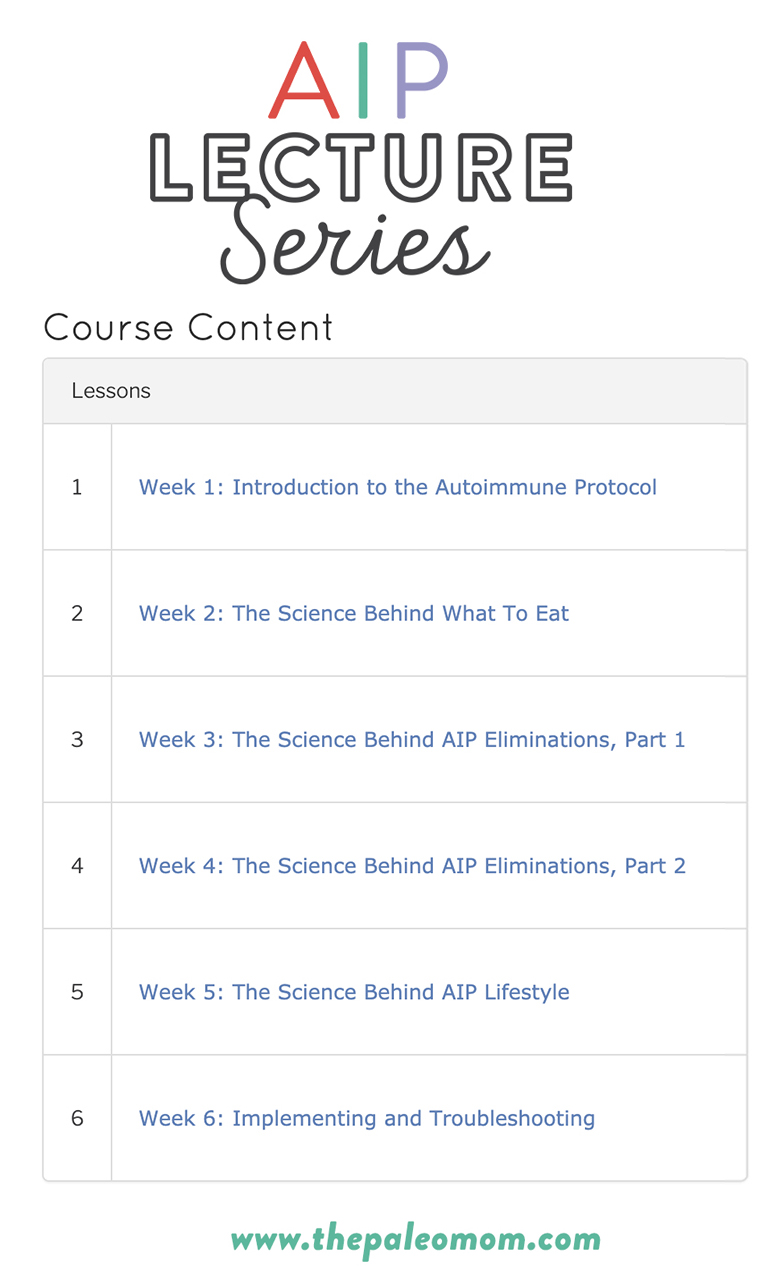 You can complete the course on your schedule. I’ve carefully planned every aspect of this course to be accessible no matter what time zone you’re in or what your schedule looks like. You can stream the video lectures on-demand, and contribute to the Facebook guided discussion, ask your questions, or watch the FAQ videos at your leisure. Also, you retain lifetime access to all of the course materials as well as the private Facebook group and all of the content shared within.
You can complete the course on your schedule. I’ve carefully planned every aspect of this course to be accessible no matter what time zone you’re in or what your schedule looks like. You can stream the video lectures on-demand, and contribute to the Facebook guided discussion, ask your questions, or watch the FAQ videos at your leisure. Also, you retain lifetime access to all of the course materials as well as the private Facebook group and all of the content shared within.
I put a tremendous amount of effort into gearing this course for all levels, including if you:
- are completely new to the idea of diet and lifestyle changes to heal from chronic illness,
- have dabbled in Paleo or AIP but had trouble sticking to it in the past,
- are an AIP veteran who already has seen great results,
- are the caregiver, supporting family or friends with autoimmune disease,
- are a practitioner looking to begin your advanced learning of the AIP.
You can benefit from the information presented in this course whether you’re in the early phases of diagnosis, are looking to reduce disease risk due to a strong family history, or have battled autoimmune disease or other chronic illness for years.
Within the AIP Lecture Series, I will teach you the scientific foundation for the diet and lifestyle tenets of the AIP, plus provide tons of tips and strategies for implementation, transition, refinement, reintroductions, troubleshooting and lifelong wellness.
And this session, I’m adding a new 75-minute lecture specifically about the link between the gut microbiome and autoimmune diseases, including how we can refine the focus of the AIP to best support a healthy and diverse gut microbiome. (And all previous students will get automatic access to the new lecture!). To help lay the groundwork for this new gut health curricula, I’m giving all students access to my Gut Health Fundamentals online course (value $159) when they register. (You’ll be able to access this bonus course right away, too!)

